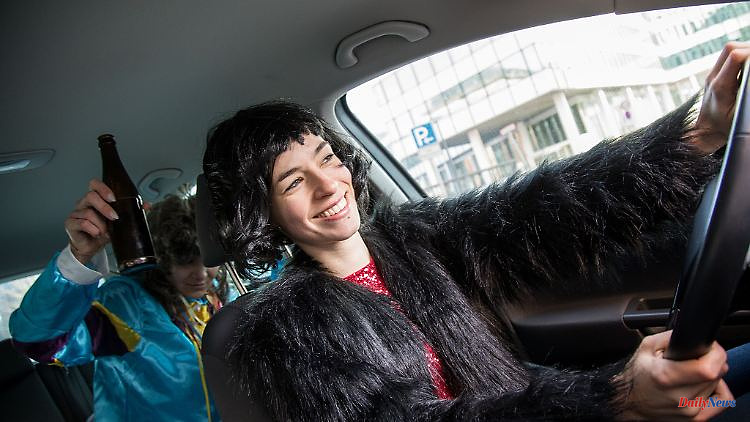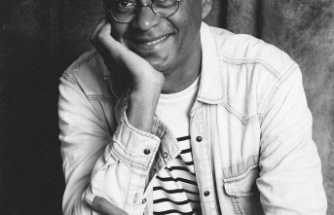The way from Alaaf and Helau to Ouch can be short. So that it remains safe on the road on foolish days, fools should consistently follow the rules.
No other dino between Munich and Mainz-Gonsenheim looks more original in his rubber costume than you? Very excellent. You will definitely be the center of attention at parties at carnival, carnival or carnival. But if you don't want to get sidetracked on the way there or back home and don't want to be responsible for serious consequences, you should also and especially with all the fun of the traffic rules. ACE, ADAC, AvD and the German Road Safety Service provide information and tips.
The same applies to clowns and lizards: keep an overview
It starts with the journey to the party. Costumes like the opulent lizard outfit or clown shoes are not suitable for driving. The costumes must not restrict sight, hearing or freedom of movement. If the view is obstructed, a fine of 10 euros is possible. If there is a hindrance or danger, there may also be a violation of general duties of care and result in a fine of between 20 and 35 euros.
Costume must not obscure face
Also, the face at the wheel must not be covered or veiled. The background is that you have to remain identifiable for traffic monitoring. Otherwise, a fine of 60 euros will be charged. But: "Not every costume is forbidden," says Felix Müller-Baumgarten. As long as the accessories show essential facial features, they are allowed. "This is usually still the case with face painting or a clown's nose," explains the ACE legal expert.
But bulky costumes and extensive masks are better packed in the trunk before the party and only become a joke on the spot. Alternatives are public transport or a taxi. Reliable sober pickers from friends or family can also be organized in advance.
Drink driving is expensive and dangerous
Local transport or taxis are also safe modes of transport of choice when it comes to alcohol. Anyone who is caught driving with 0.5 to 1.09 per mille alcohol in their blood has to dig deep into their pockets. Without any further abnormalities, such drunkards are then fined 500 euros, two points in Flensburg and a month's driving ban.
In addition, you endanger yourself and others, in the worst case with fatal consequences. There is an absolute ban on alcohol for novice drivers during the probationary period and for everyone under the age of 21. Otherwise, a fine of 250 euros and one point will be due. In addition, an advanced seminar is mandatory and the probationary period is extended from two to four years.
Even with a relatively low blood alcohol level, a criminal offense can be committed
Criminal penalties may follow earlier. Driving under the influence of alcohol between 0.3 per mille and 1.09 per mille in connection with so-called alcohol-typical failure symptoms is considered a criminal offence. This is the case if there is an accident or if you drive in a conspicuous manner, such as wavy lines.
This relative unfitness to drive is followed by fines, a driver's license suspension of several months and three points. According to the ADAC, even imprisonment with or without probation can threaten repeat offenders or alcohol-related accidents with personal injury.
Absolute unfitness to drive with at least 1.1 per mil
The absolute unfitness to drive is reached with 1.1 per mil and it is automatically a criminal offence. With no additional evidence required, penalties and a driver's license suspension of several months and three points follow. In addition, an MPU can be arranged. From 1.6 per thousand, the MPU is automatically mandatory, even for cyclists.
Incidentally, the values mentioned also apply to motorcyclists and users of electric scooters. For repeat offenders, the sanctions imposed increase significantly.
Blue on a bike is easy to spot
On a bicycle and pedelec, absolute unfitness to drive is only achieved with a blood alcohol level of 1.6 and is immediately considered a criminal offense with a fine of 30 daily rates, according to the ADAC. But here, too, an existing driver's license is at risk because of the MPU and there are two points. Cycling can even be banned entirely.
However, as with motor vehicles, there are already criminal consequences from 0.3 per mille if, for example, snaking lines are driven. According to Müller-Baumgarten, the range of penalties is lower than for a car.
Drinking to the limit is not a good idea
All well and good, but you just want a beer or two? There are breathalyzers. Not a good idea either. Because there is a lot of information and sensory impressions to be absorbed and processed behind the wheel. Sometimes you have to react in fractions of a second. According to the ADAC, this requires top physical and mental performance even when sober.
Even small amounts of alcohol can have a negative impact on driving ability, for example with regard to concentration and perception. In addition, the willingness to take risks increases and the pace can be misjudged.
Please no breathalyzers as indicators
And how do you want to reliably determine blood alcohol levels? Because the security that alcohol testers are supposed to offer for private use is deceptive. "An inexpensive breathalyser for a few euros does not provide a reliable breath alcohol value," warns traffic psychologist Marie-Christin Perlich from TÜV Thüringen. They could even encourage unwanted drink-driving because drivers feel a false sense of security with them. On the one hand, the measurement result can deviate greatly from the actual alcohol level in the blood due to the inaccuracy of the devices.
On the other hand, there is the danger that one tries to "drink oneself up" to a certain limit. However, values measured directly after consumption can be highly falsified due to the delayed build-up of the alcohol level in the blood.
Danger also looms the morning after
Such alcohol test devices could still be useful. And the day after. Even if these are not comparable to the professional devices used by the police, they can provide a clue, but only in the following sense: If the device shows more than zero blood alcohol levels, the vehicle should better stop.
Although sleeping, drinking coffee or showering may increase well-being, they do not accelerate the breakdown of residual alcohol like other supposed miracle cures. As a rough guideline, the body only breaks down around 0.1 per thousand per hour. People also tolerate alcohol differently.
According to the ADAC, this depends on gender, size and weight and gives a rough example: A man weighing 80 kilos drinks four half liters of beer and at 1 a.m. theoretically has a blood alcohol level of around 1.4 per mille. The 0.3 per mille limit would only be undershot around noon. That's the theory. In practice, however, the breakdown of alcohol is also very individual and depends on many factors.
One thing is certain: Anyone who spends late at night with beer, schnapps and the like will certainly not be able to drive again in the morning. Then even the most original dinosaurs are better off walking or being driven. Anyone who causes an accident under the influence of alcohol not only has to live with the guilt and fear legal consequences, but also gets into trouble with the insurance company.
The motor vehicle liability insurance does cover the damage caused by third parties. However, the insured person can be taken into recourse, usually up to an amount of 5000 euros, according to the ADAC. In addition, any existing comprehensive insurance can reduce or even cancel the payment of your own damage depending on the degree of alcohol consumption.












